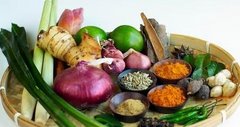
Paella is a one of the world's most famous rice dishes, and this version is a seafood extravaganza. Traditionally, paella is prepared in a paellera (a wide, shallow pan with looped handles) and cooked over an outdoor fire. However, it's easy to cook paella to authentic perfection in your own kitchen over the stovetop. The following paella recipe serves 4.
Ingredients:
- onion, finely chop
- 1 red capsicum (red pepper), dice
- 5 garlic, finelly chop
- 2 tbsp fresh flat parsley, finelly chop
- 2 cups of canned peeled tomatoes, mashed with a fork.
Preparing the safrito:
Sofrito is a Spanish tomato and onion sauce which is used as a flavor base for a variety of dishes, including paella. Put in 2 tbsp extra virgin oil in a pan over a medium fire. Add in chopped onion, flat leaf parsley and 3 of the finelly chopped garlic for 6 minutes. Stir occasionally. Add in the pureed tomatoes and and 2 tsps of smoked paprika and cook until all the liquid from the tomatoes has evaporated and the safrito has the consistency of jam.
Preparing the seafood:
While the sofrito is cooking, place the mussels in a saucepan with half a cup of simmering water. Cover and steam on a low heat for 5 minutes. Remove mussels and set aside, discarding any that haven't opened.
Heat 1 tablespoon of extra virgin olive oil in the paella pan over a medium-high heat. Add the remaining clove of chopped garlic and the shrimp and cook for 1½ minutes, tossing continuously. Add the squid rings and cook for a further 1½ minutes. Remove the shrimp and squid from the paella pan and lightly season with salt and freshly ground black pepper. Cover and set aside.
Method:
Heat 2 tablespoons of extra virgin olive oil in the paella pan over a medium heat and cook the diced red peppers for 5 minutes, stirring occasionally.
Add the sofrito back to the pan along with 1½ cups of Spanish rice and cook for a minute, stirring to coat the grains.
Add 3 cups of heated fish or chicken stock*, 1½ teaspoons sea salt and ½ teaspoon freshly ground black pepper. Stir to combine, and bring to a rolling simmer. Cook for 10 minutes, uncovered without stirring. (To make sure the rice cooks evenly you will need to regularly move the paella pan around the heat source, or you can stradle the paella pan over two burners.)
Lower the heat and continue cooking
Lower the heat to a gentle simmer and cook for a further 15 minutes without stirring. After 15 minutes, turn the heat up to medium-high for a minute or so until you can smell the rice toasting at the bottom, then remove the paella pan from the heat.
Push the reserved shrimp, mussels and squid into the cooked rice, and scatter with half a cup of defrosted green peas. Cover the pan with foil or a clean cloth, and let the paella rest for 10 minutes. Serve with lemon wedges
Present the paella in the pan at the table with lemon wedges on the side for drizzling.
*you may make your own fresh stock or otherwise use the ready available stock from supermarket.








